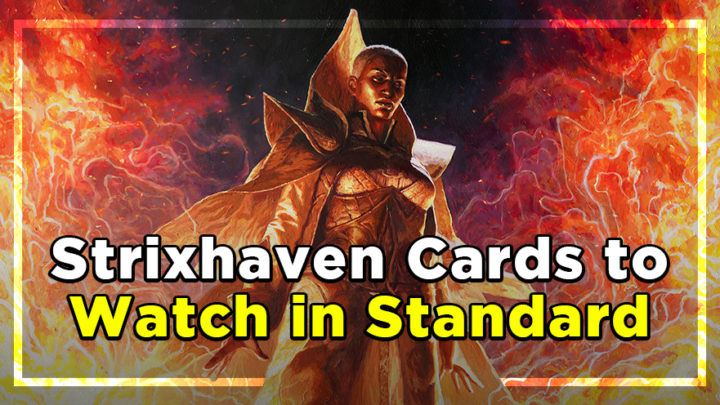By now, we’ve seen all the cards from Strixhaven: School of Mages. But with a week to go before the set hits MTG Arena, we’re all left in a state of hype to play with the new cards. Today, I’m going to go over five cards that you’ll need to keep an eye on going into this Standard season.
Mavinda, Students’ Advocate

Of all the cards we’re going to talk about today, Mavinda might be the most ambitious. It looks like it will be a key piece in magecraft creature decks, since it will allow you to trigger those creatures multiple times with a single card.
Mavinda reminds me a lot of Feather from War of the Spark, so my mind immediately jumps to cards that work well in that setting. Of these, Defiant Strike seems like the strongest card to play alongside Mavinda. This will allow you to trigger all your magecraft abilities while moving through your deck in search of more spells. Strike was a mainstay in heroic decks of the past, and it should continue to do good work here.
Snakeskin Veil is also looking to be a big player in Mavinda decks. You really want to keep your card advantage engine safe, and this serves not only as a way to do that, but a way to buff it up and dodge removal spells like Heartless Act. Another thing to keep in mind is that Mavinda allows you to cast a spell from your graveyard on either players’ turn, so reactive spells are welcome here.
Mavinda does have a drawback — if the spell you cast doesn’t target one of your creatures, you have to pay an additional eight mana for it. But there’s a creative way to get around that while dealing with your opponents’ creatures: spells with multiple targets. Cards like Blizzard Brawl and Inscription of Abundance will allow you to control your opponents’ boards while still triggering magecraft and saving you a ton of mana on Mavinda activations.
Baleful Mastery
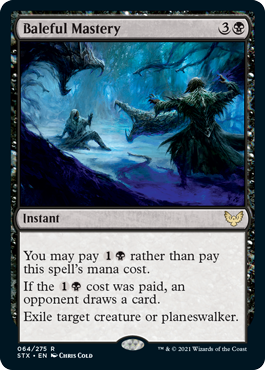
This card has gotten surprisingly little love. It’s a slightly worse but easier to cast Vraska’s Contempt, but it has a huge option that card didn’t have: an alternate casting cost. While 1B is an incredibly good rate for this effect, letting your opponent draw a card is a serious drawback.
That being said, even casting this card for the 1B mode will often buy you a turn when you’re about to lose. Have you ever been playing a reactive deck and had to play a Triome on turn three? Then your Mono-Red opponent Embercleaves their Anax and attacks for lethal? I would much rather give my opponent a card and continue playing the game than lose on the spot.
This card seems great for control decks, as they are always looking for cards that can answer a wide range of threats. This will shine as a one- or two-of in Rogues, which often wants to be able to get rid of escape creatures permanently.
Rip Apart
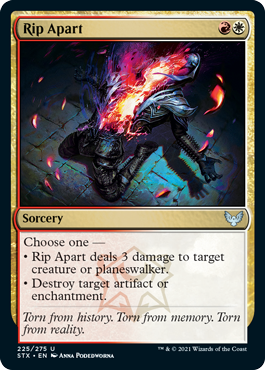
This is looking to be one of the best catch-all’s red and white decks have ever had. Rip Apart draws eyes and has people thinking back to Abrade. While a bit harder to cast than Abrade, this card does answer a wider array of cards.
I don’t think we’ll see many Rip Aparts in main decks, but I do expect a good amount to be coming in post-board. This card really checks decks like Mono-Red and Gruul, so if we see those decks start to rise up again, I expect this card’s stock to rise. The only thing potentially holding it back is how popular Red-White decks end up being, but time will tell.
Silverquill Silencer
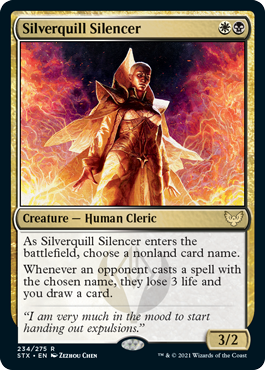
This card is a new take on Meddling Mage. Your opponent can still cast the card you choose, but only at an incredibly high price. This card forces your opponent to have an answer to it, or else their key card might become more of a liability than an asset.
While this card doesn’t have an obvious home right now, that doesn’t mean it won’t see play. This card has an aggressive slant, so we could see decks like Silverquill Aggro become a thing. Decks like that often want ways to punish wraths, and this is a main deck card that does just that.
We’ve already heard cries of, “It’s an X/2! It dies to Bonecrusher Giant!” — which is a true statement, but not necessarily a relevant one. While Silverquill Silencer does die to Stomp, and Stomp is one of the best removal spells in the format, the card may very well still be playable. According to MTGGoldfish, Bonecrusher Giant is played in about 36% of decks. If things continue to trend that way, you’ll only see Bonecrusher in roughly a third of your matches. That’s not quite enough to stop me from trying out this card.
By the way, did I mention that you can name the same card multiple times if you have more than one Silverquill Silencer? Now that’s a spicy meatball.
Test of Talents
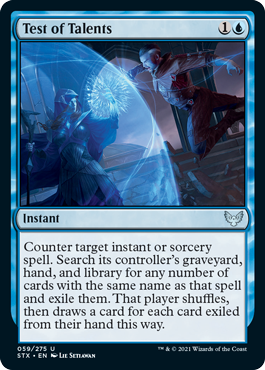
This card has an obvious application in Standard: finally putting Sultai Ultimatum players in their place. Test of Talents excels at breaking up combo decks by allowing you to remove the key piece from the game. Expect to see this become omnipresent in blue sideboards for as long as people continue to play Emergent Ultimatum.
I think Test of Talents also has a chance to creep into main decks — and not just as an answer to combo. This card could make the cut as more and more decks start relying on big spells to refuel, stabilize, or win the game. Countering cards like Into the Story or Shadows’ Verdict seems quite powerful. At worst, Test of Talents is a slightly narrower Negate, which allows you to be more flexible and reactive in your games.
***
We have one more week till school is in session. Which card are you most excited for? Tweet at @masoneclark and @card_kingdom and let us know!

Mason Clark is a grinder in every corner of the game who has played at the pro level and on the SCG Tour with Team Nova. Whether he’s competing in Standard, Historic or Modern, Mason plays with one goal in mind: to be a better player than he was the day before. Check out his podcast, Constructed Criticism, and catch his streams on Twitch.

